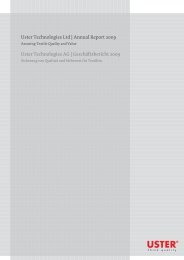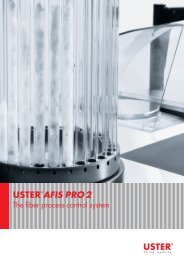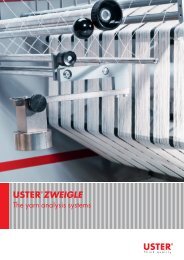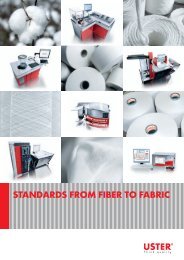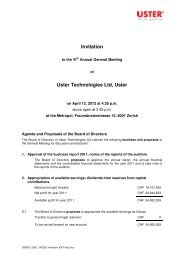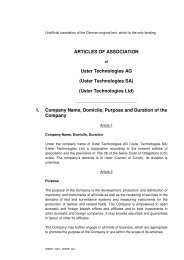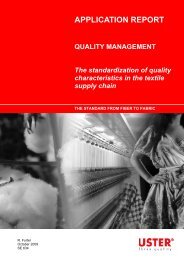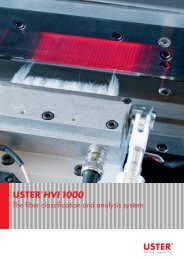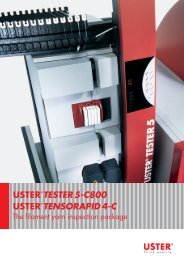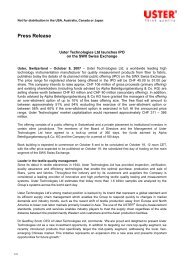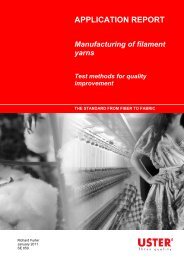Application Handbook_Uster_Statistics - Uster Technologies
Application Handbook_Uster_Statistics - Uster Technologies
Application Handbook_Uster_Statistics - Uster Technologies
- No tags were found...
You also want an ePaper? Increase the reach of your titles
YUMPU automatically turns print PDFs into web optimized ePapers that Google loves.
5.2 Restrictions Imposed by the Final ProductIt lies in the nature of the matter that end uses remain somewhat vague when yarns are marketed viamerchants or importers. It is rare for any merchant to have firm orders before entering into a contract.Consequently, the focus is on obtaining qualities that are likely to meet the requirements of anypotential customer and which can be successfully marketed in many places and at any given point intime. In the current buyer’s market, merchants have a large number of alternative sources to choosefrom. Yet, to minimize risk, commodity type yarns with high volume of trade are preferred. Underthese circumstances, specified and actual quality requirements seem to have very little in common.5.3 Restrictions Imposed by the Yarn DesignWhen properly tailored to the anticipated end use, yarns will exhibit inherent strengths andweaknesses: As opposed to weaving yarns, for instance, knitting yarns produced from cotton, manmadefibers, or blends thereof are spun at low twist multipliers. They will rarely display a highbreaking tenacity. If they did, they would probably result in stiff, harsh fabrics. A somewhat lowerbreaking tenacity must also be expected from knitting yarns spun from low-tenacity or pill-resistantman-made fibers which are specifically designed for that purpose. Such low-tenacity fibers, however,usually result in excellent yarn elongation. Knitting yarns also possess a higher hairiness. While thiswould be detrimental to weaving yarns, the knitted fabric enjoys a greater cover and a softer hand. Tomake it clear: It is technically impossible and fatal with respect to the end use to demand that a yarnbe perfect in all categories, say above the 25% line of the USTER ® STATISTICS. The proper way outof this dilemma is for the yarn producer and the yarn processor to jointly develop detailedspecifications or requirement profiles for specific end uses. Many good examples of this partnershipapproach have become known and the USTER ® STATISTICS can be of tremendous help in realizingsuch projects.5.4 Missing Correlation between Different Quality CharacteristicsUnfortunately, the USTER ® STATISTICS still mislead some people into thinking in causalrelationships that do not exist in reality. Several quality parameters displayed in the STATISTICS arebelieved to be highly correlated but the fact is that they are not. High breaking tenacity, for instance, isnot necessarily linked to high breaking elongation; rather, yarn elongation is determined by spinningspeed, spinning geometry, and the resultant specific spinning tension. Likewise, a very even yarn maywell have a high nep count. End uses calling for a relative freedom of neps cannot be satisfied byusing yarns with a good USTER ® CV m . The opposite is sometimes the case: Few neps in a veryuniform yarn tend to visually stick out like a black sheep. Yarns with a little higher CV m or greaterhairiness tend to conceal neps in the overall irregularity, much like the often quoted needle in ahaystack. If there is a problem with neppy appearance and no way to reduce nep counts, try to go alittle higher with the CV m .USTER ® STATISTICS 32 (36)



